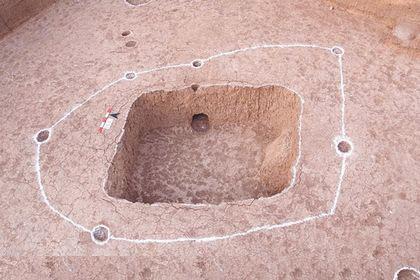A Settlement Site from Eastern Zhou Dynasty Found in Yanqing, Beijing
Chinese Archaeology
Source - http://www.kaogu.cn/en/detail.asp?ProductID=3011
Since 11th March 2011 Beijing Cultural Relics Institute has launched a rescue excavation to the Hujiaying site in cooperation with Yanqing County Cultural Relics Administration. By far approximately 60 archaeological remains have been uncovered, including 24 house sites, 21 ash pits, 11 ovens and 4 ditches. Unearthed objects fall into five categories like ceramics, stone, bone, iron and bronze.

The site is located at the Hujiaying village in Zhangshanying Township, Yanqing County, Beijing. The excavation area consists of two parts. Part I has two wide trenches spreading in the south. One of them G2 contains massive sand and stone deposit indicative of an original river course. Most house sites are found on the north bank, showing people at that time were used to living along a river.

Majority of house sites are semi-subterranean dwellings with rectangular, nearly round or irregular plan shapes. A house site usually is composed of doorway, pillar holes and floor. Few sites have an oven. The doorway, toward the north-west, the east or the south, seems to be arranged without a certain law. The ovens are built with stone or earth. In addition, in the house site F21 there is a wall-type earthen oven. All ash pits are in the sack shape with a small well-shaped opening and a broad bottom. Their depths measure normally less than 1.5 m.

Unearthed objects include ceramics, stone, bone, iron and bronze wares, with ceramics constituting the majority, which are mainly various stemmed cups, jars with a curved shoulder, sand-mixed cauldron, sand-mixed li tripot and swallow-style li tripot. There are also pats, plates, urns and zeng vessel, etc. These ceramics on the whole exhibit features of that time. For example, the early period witnesses more sand-mixed and brown ones which are simply made, and in the later period there are appeared more well-shaped fine clay and gray potteries demonstrating high wheel-making technique.

There is also a large variety of stone tools including axes, adzes, balls, knives and halberds. Some polished stone disk and other objects could be seen. A large number of bone objects, such as awls, needles, hairpins, arrow heads and shovels, have been found. Iron objects include axes, sickles, ring-handled knives, hoes and awls. Bronze wares only include arrow heads and awls. Besides, a bronze arrow head with iron shaft has been found.

CIV 108 - 208 : Civilisations de la Chine antique / Ancient China : Origins to Empire
The cultural deposit in the site could be divided into five layers. The upper three belonging to the late period yield few objects. The fourth layer yields many ceramic pieces from the Han Dynasty and objects from the Warring States period, including well-shaped fine clay jars, fine clay Dou vessel, and mica- and sand-mixed brown cauldrons, which could be assigned to the Han Dynasty. The fifth layer contains many mica-mixed red or brown pottery cauldrons, dating back to the Warring States period. Under the fourth layer there are archaeological remains like stone-built ovens numbered Z1, Z3 and Z7, and the house site F18 which is nearly round in plane and remains stone pillar bases. Situated between the fourth and fifth layer, they could be thus dated back to the period between late Warring States and early Han Dynasty.
Majority of house sites and ash pits are discovered under the fifth layer, which constitute the majority of findings. Uncovered house sites are remarkably different from those well-shaped house sites in the Central Plain. Due to that the site is located at the borderland between the Central Plain culture and the North culture, it is reasonable that it demonstrates complex cultural phenomena.
The region where the Hujiaying site lies is a transitional zone between the northern nomadic culture and the Central Plain farming culture. The unearthed cultural relics, which bear strong regional features of the Eastern Zhou period, represent a picture of semi-settled living ways in northern ethnics and provide new materials for studying the ethnic affiliation of the local culture as well as cultural exchanges between the South and the North. (Translator: Tong Tao)